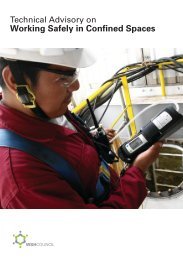HERE - Workplace Safety and Health Council
HERE - Workplace Safety and Health Council
HERE - Workplace Safety and Health Council
You also want an ePaper? Increase the reach of your titles
YUMPU automatically turns print PDFs into web optimized ePapers that Google loves.
3. LifelinesLifelines, provide links between the anchorage <strong>and</strong> the user which has an effective length thatcan be adjusted or altered by the use of a mobile lifeline device.In general, lifelines should have the following characteristics:• It should have a safe rating high enough to withst<strong>and</strong> forces or tension being generated inthe event when it is in use; <strong>and</strong>• It should not interfere with any other items of equipment (e.g., safety equipment orclothing) with which it is to be used.If the lifeline is purchased as a system, it is important to note that a lifeline together with theanchor devices must be used as a system <strong>and</strong> each part should not be used independently asspecified by the manufacturer. Components from different manufacturers should not be usedtogether unless it is specified or advised by the manufacturer.3.1 Use of Lifelines at AnglesLifelines are type tested together with their lifeline devices either vertically or horizontally. Ifthey are to be used at angles deviating from the vertical or horizontal, the manufacturer shouldbe contacted for advice. When necessary, additional tests may be required to be carried outin the presence of a Professional Engineer (PE) to ensure integrity of the lifelines <strong>and</strong> anchordevices.Textile lifelines used for fall arrest systems should be as follows:• kernmantel ropes conforming to BS EN 1891 : 1998, type A - Personal protective equipment forthe prevention of falls from a height. Low stretch kernmantel ropes;• hawser-laid polyamide ropes conforming to ISO 1140 : 2012 - Fibre ropes -- Polyamide--3-, 4-,8- <strong>and</strong> 12- str<strong>and</strong> ropes; <strong>and</strong>• hawser-laid polyester ropes conforming to ISO 1141 : 2012 - Fibre ropes -- Polyester--3-, 4-,8 - <strong>and</strong> 12- str<strong>and</strong> ropes.3.3 Textile Lifelines3.3.1 Selection of Textile LifelinesDifferent types of textile lifelines have different elongation characteristics. Therefore, great careis required in selecting the proper type to use.In general, kernmantel ropes (conforming to BS EN 1891 : 1998, type A - Personal protectiveequipment for the prevention of falls from a height. Low stretch kernmantel ropes) are recommendedfor work positioning systems, other than rope access systems. If hawser-laid ropes are used aslifelines, those conforming to ISO 1140 : 2012 - Fibre ropes -- Polyamide--3-, 4-, 8- <strong>and</strong> 12- str<strong>and</strong>ropes for hawser-laid polyamide ropes or ISO 1141 : 2012 - Fibre ropes -- Polyester--3-, 4-, 8 - <strong>and</strong>12- str<strong>and</strong> ropes for hawser-laid polyester ropes are recommended.3.2 Lifelines Conforming to International St<strong>and</strong>ardsFor fall arrest systems, Table 2 shows a list of recommended lifelines conforming to internationalst<strong>and</strong>ards <strong>and</strong> should be used.Types of Fall Arrest SystemsGuided type fall arrester <strong>and</strong>a rigid vertical lifelineGuided type fall arrester <strong>and</strong>a flexible vertical lifelineLifelines (Conforming) St<strong>and</strong>ardsSS 528 : Part 4 : 2006 Personal fall-arrest systems: Verticalrails <strong>and</strong> vertical lifelines incorporating in a sliding-type fallarresterFigure 10: Examples showing a kernmantel (left) <strong>and</strong> hawser-laid lifeline.3.3.2 Knots for Textile LifelinesTermination loops on textile rope lifelines are usually formed by splicing or sewing but theycan also be formed by knots. Some lifelines come with knots already tied by the manufacturer.Otherwise, they can be tied by a competent person.System based horizontalflexible lifelineSystem based horizontalrigid lifelineTable 2: Recommended lifelines for different fall arrest systems.SS 570 : 2011 Personal protective equipment forprotection against falls from a height - single point anchordevices <strong>and</strong> flexible horizontal lifeline systemsIt is important to note that there can be subtle differences between one knot <strong>and</strong> another asthese are created due to slight twists imparted during tying of the knots <strong>and</strong> even when theywere tied by the same person. Therefore, it is essential that knots are only tied by the samecompetent person who has thorough knowledge of knots <strong>and</strong> knots tying techniques.Knots should never be used to connect a safety lanyard to any anchor points. The tails of all knotsshould be at least 100mm long <strong>and</strong> the knots should never be tied in lifelines made from wire ropes.16 17
















